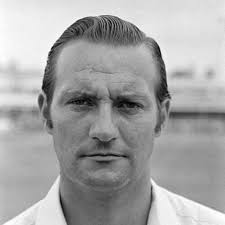- Obituary notices referred to him as the 'Grand Old Man of Derbyshire Cricket' His better known contemporaries were dead long before him and I would have loved the opportunity to quiz him further on his era and the characters who made it special.
Further? Unlike anyone else in this series, Levi Wright put down his memories in a manuscript that was published by the Derbyshire CCC Supporters Club in 1980, having been written and given to a friend around forty years earlier. It would have benefited from a little editing and one gets the impression in reading it, which I have done many times, that the player just sat down and wrote, perhaps without even revisiting it.
Nonetheless it is a priceless contemporary account of county cricket in the late ninteenth and early twentieth century and packed with anecdotes and pen portraits of its greatest characters, while Wright comes across as a modest man. Not only did he play for Derbyshire between 1883 and 1909, he also played football for Derby County and was good enough to be selected as a full back and centre half for the North v South game, as well as a reserve for the full England side.
The longevity of his career accounts for a batting average of 'only' 26. While he was always a stylish player, easy on the eye as he drove and deft in his placement of the cut and late cut, he didn't make his first century until he was 35 years old and reached a thousand runs for the first time at the age of 37. Such late flowering would be impossible today, yet between 1897 and 1906 he reached his thousand runs on six occasions. In 1905, at the age of 43, he was elected one of Wisden's Cricketer's of the Year, with 1855 runs at an average of 42.
He was an easy and automatic choice throughout that period, not only for those runs (he scored 20 centuries and 72 fifties) but also for his brilliance in the field, where he earned the reputation as one of the finest cover points in the game. His speed over the ground was a factor, but he held his share of catches that confirmed a safe pair of hands. This set him apart from a team that was otherwise not known for the quality of its fielding. His book refers to one player who put down six catches in one day...
Having flowered late, it is fair to say that he went on for a few years too long. His average dropped from 20 to 19 to 11 in his final seasons, which would have been sad to witness for supporters who had long enjoyed the style of his batting. Curiously, his last four centuries all came against the same county, Warwickshire, three at Edgbaston before his final 'ton' came at Derby, in 1908. It was a poor era for Derbyshire cricket, however and there were no real alternatives to an ageing professional.
When his playing days ended he continued as a clerk for the Midland Railway, a job he had held through the winter months, before becoming a regular at the County Ground in retirement. He lived for over forty years at 42, Derby Lane in Normanton, where he was remembered as a jovial man, always happy to talk about sport. He was a keen bowler too, a regular at the Arboretum Bowling Club.
Sadly, an interview with him in 1938, for the BBC Radio sports feature Cricket Interval was inadvertently wiped.
What a pleasure that would have been to hear.
(Image sourced courtesy of David Griffin from the Derbyshire CCC Archive)



